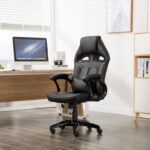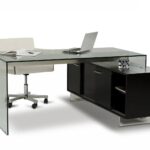Choosing the right office chair is more than just about aesthetics or price—it’s a decision that significantly impacts your comfort, posture, and work efficiency. Whether you’re working from home or in a corporate environment, the chair you sit in every day can be the difference between sustained productivity or daily discomfort. Prolonged sitting, especially on a poorly designed chair, can lead to serious health concerns such as back pain, poor posture, and circulation issues. This is why selecting an ergonomic, adjustable, and supportive office chair is essential for both physical health and professional performance.
Modern-day work culture often demands long hours of desk work, making your office chair an important investment rather than just a piece of furniture. A good chair not only supports your spine but also encourages better posture, reduces stress on your joints, and improves overall comfort. When you’re physically comfortable, it becomes easier to focus on your tasks, reducing fatigue and boosting efficiency throughout the workday.
Key Features to Look for in an Ideal Office Chair
When shopping for an office chair, certain features should be non-negotiable if you want to maintain good health and productivity. Firstly, adjustability is critical. A chair that allows you to adjust the seat height, backrest tilt, and armrests ensures it can be customized to your body dimensions. This is important because everyone has a unique sitting posture and body shape, and a one-size-fits-all chair rarely suits everyone.
Another essential feature is lumbar support. The human spine naturally curves, and sitting in a chair without proper lower back support can strain your back muscles and spinal discs. Good lumbar support encourages the natural curve of your lower back, promoting good posture and reducing pain. Also, look for high-density foam or breathable mesh in the seat and backrest. These materials provide durability and comfort while allowing for air circulation, which helps prevent sweating and overheating during long hours.
Lastly, swivel and mobility features should not be overlooked. A 360-degree swivel and smooth-rolling casters make it easier to move around your workspace without straining or twisting your back. The base should be sturdy, preferably a five-point base for added stability.
Ergonomics: The Science Behind a Comfortable Office Chair
Ergonomics is the science of designing products to best suit human use. When applied to office furniture, it focuses on creating tools and environments that enhance comfort, safety, and productivity. An ergonomic office chair is designed to support your body in a neutral posture, meaning your joints are naturally aligned to reduce muscle strain and fatigue.
Ergonomic chairs usually offer features like seat depth adjustment, adjustable armrests, and headrests to reduce tension in the neck and shoulders. This attention to detail is not merely a luxury—it’s a necessity in today’s fast-paced work environment where long hours in front of a screen are common. Sitting ergonomically helps reduce the risk of developing chronic conditions such as carpal tunnel syndrome, herniated discs, and cervical spondylosis.
"Give thanks to the Lord for He is good: His love endures forever."
Investing in an ergonomic office chair is an investment in your long-term health and work efficiency. It promotes proper posture, improves blood circulation, and even encourages better breathing by aligning your torso correctly, which may reduce fatigue and increase alertness.
Office Chairs for Different Work Environments
The type of office chair you need depends largely on your work environment. For traditional office settings, executive chairs are popular. These chairs are larger, often with high backs, and typically include ample padding and support. They are ideal for managers or those who spend extended periods at their desk.
If you work in a collaborative or co-working space, task chairs are a great choice. They’re more compact, easy to maneuver, and designed for dynamic movements. For creative professionals, such as designers or architects, drafting chairs with foot rings and taller height adjustments can be ideal, especially when working on higher desks or platforms.
Remote workers or home office users often prefer mid-back mesh chairs, which offer a good balance of support, breathability, and affordability. These chairs are suitable for smaller spaces while still maintaining ergonomic design principles. Some people even opt for kneeling chairs or saddle stools to promote active sitting and strengthen core muscles over time.
The Psychological Benefits of a Quality Office Chair
Aside from physical benefits, the psychological effects of a good office chair are equally important. When you sit in a chair that feels good and supports your body, your mind tends to follow. A supportive chair can improve your mood, reduce stress, and help you stay focused for longer periods. When discomfort is not constantly drawing your attention, you can better immerse yourself in your work.
Additionally, using a well-designed office chair sends a signal to your brain that it’s time to be productive. Just like dressing professionally for a virtual meeting can influence your mindset, sitting in a dedicated, ergonomic chair can help you mentally separate work from relaxation, especially if you’re working from home. This can lead to better work-life balance, less burnout, and a more positive overall experience with your job.
Maintenance Tips to Prolong the Life of Your Office Chair
Proper maintenance of your office chair can significantly extend its lifespan and preserve its functionality. Regularly clean the upholstery or mesh fabric according to the manufacturer’s instructions. Dust and debris can build up and degrade the material over time, especially on mesh-backed chairs. For leather or faux leather chairs, using appropriate cleaners will keep the surface supple and prevent cracking.
Tighten any loose screws and check the wheels and gas lift mechanisms regularly. If you hear creaks or notice uneven rolling, it might be time to lubricate the moving parts or replace the wheels. Also, avoid overloading the chair beyond its weight capacity and don’t use it for unintended purposes, like standing or as a ladder substitute.
Caring for your office chair not only keeps it looking and working like new but also ensures that your investment continues to provide ergonomic support for years.
Conclusion
In today’s digital era, where long hours at the desk are unavoidable for many, investing in a high-quality office chair is one of the smartest choices you can make for your health and productivity. A chair that supports your posture, reduces physical strain, and enhances comfort can lead to noticeable improvements in your daily work routine and overall well-being. Don’t treat your office chair as an afterthought—make it a priority in your workspace planning. Whether you’re outfitting a home office or a corporate setting, the right chair can make all the difference. For lasting quality and ergonomic excellence, trust the brand name office chair to support your success.








